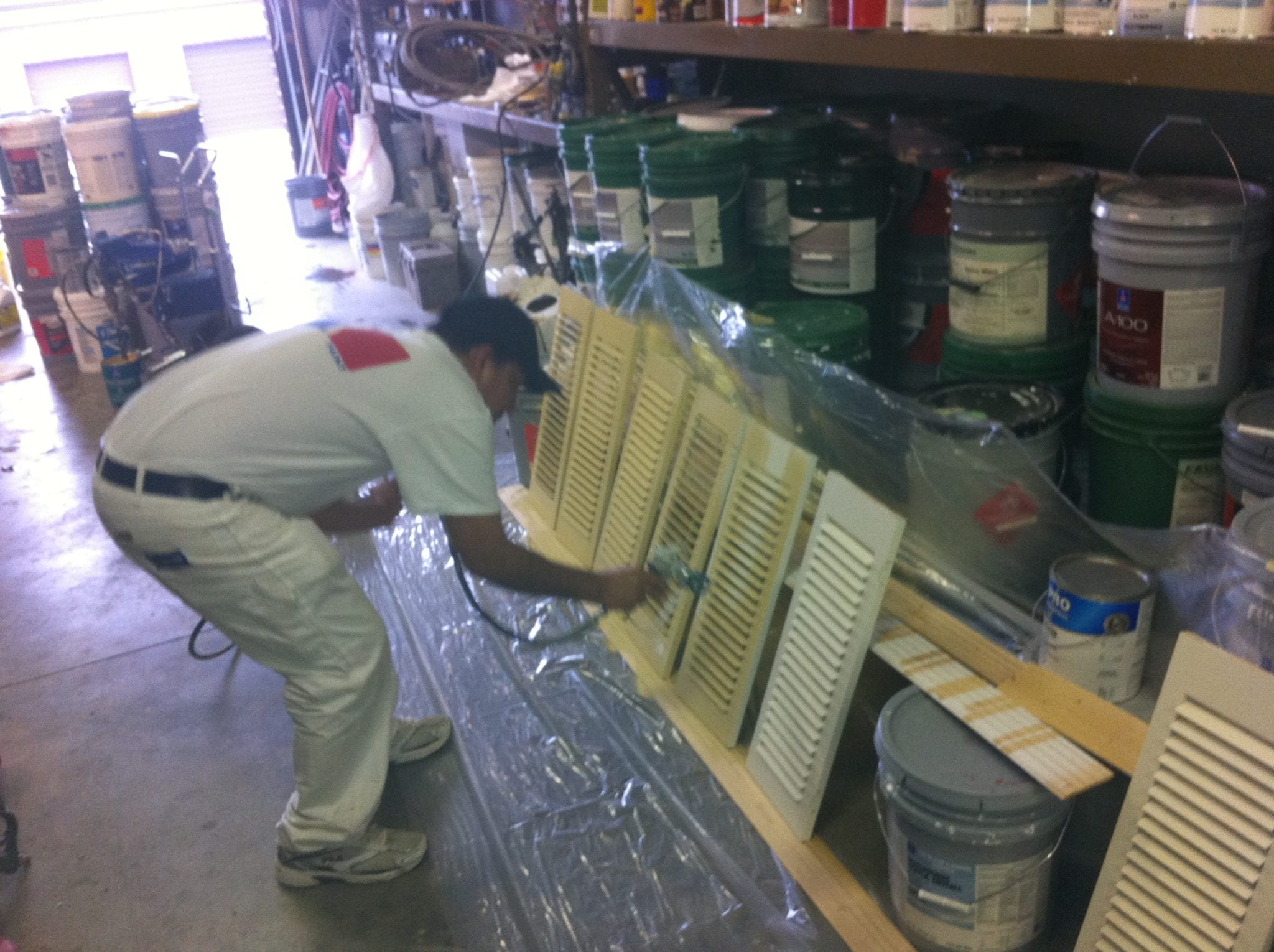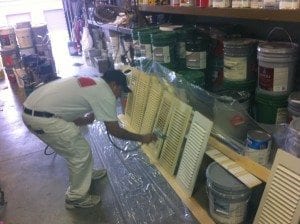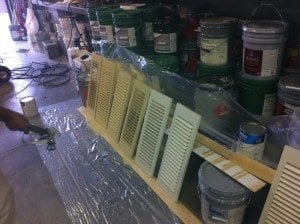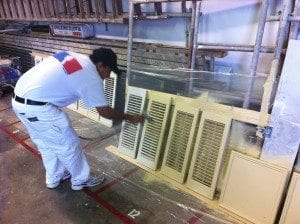Painting plantation shutters is something that is probably best left to a professional.
Simply due to the fact that most individuals do not have the equipment or training to make the shutters look well done. If you goop some paint on a shutter…. Bad news… Let me try to explain the process that our craftsmen perform on plantation shutters.
- Remove and label all shutters – then move to a controlled area where they can be properly coated and left to cure without being disrupted.
- Sand all surfaces with fine grit sand paper or a sanding sponge so that the new coating will have a good surface to bite into.
- Apply two coats of high quality oil based interior paint. (The shutters may need to be primed prior to coating)
- We like to use Sherwin Williams Proclassic Oil. We have found that Proclassic goes on very easily and levels out really well. It also dries very hard and is not susceptible to issues other paint might have like sticking. When painting any trim Oil Based paint is generally a good thing!
- Allow proper dry time between coats and allow shutters to cure for at least what the paint manufacturer suggests, if not longer.
- When any paint “cures” it becomes hard and the finish is less likely to get blemished. There is potential for the shutters to get scratched during transport and installation, but allowing the paint to fully cure will help reduce the potential problem.
- Re-install the shutters in their appropriate locations and touch up any spots if needed.
Removing and re-installing the shutters are not a difficult task.
Sanding and prepping the shutters are tedious, but not too difficult either. Properly coating the shutters is where most novices will have a significant issue.
If a person were to try and brush every single louver on a shutter it would take a great deal of time. It would also take a great deal of skill and patience, because inevitably the individual would get too much paint on one of the corners and they would start to get drips and runs. Once you load too much paint on the surface it is very difficult to get it right. When the paint has dried it will essentially “glue” the louvers in place and make operation of the shutters very difficult and sticky! In reality the only way to properly coat a plantation shutter is with a paint spraying pump. And I don’t mean one of those “handy man” specials you can pick up at your local hardware store!
We use a small Graco air assisted airless paint spraying pump with a fine finish furniture tip for all of our cabinet and precise painting work. This type of pump enables us to control how much paint comes out of the tip and at the right pressure. If you spray something too hard you will get:
– Too much paint on the surface causing runs
– Back spray where the paint hits the surface and bounces off creating a mess
– Too much over spray that wastes material
When you are better able to control the pressure and the pattern you can really do some fine detail work which is just what you want when painting plantation shutters or any substrate that is highly detailed. A professional paint spray pump will properly atomize the paint so that whatever you are spraying will have a uniform finish. While cheap pumps just “spit” out the paint like a squirt gun!
Once you have the proper product, the right equipment, and have done the necessary preparation – you still have to know how to do it! The only way to learn how to spray is to practice. Lucky for you our quality craftsmen have done a LOT of painting and know just how to apply the right product, the right amount of product, with the right equipment, and achieve a beautiful consistent finish. If I were to hire a painting contractor to perform fine work at my home I would make sure to ask for references, pictures of past work, and I would ask what type of procedure & equipment they were going to use. If they are not able to produce these things then you may need to keep on looking for the right person to perform the work.





Great Article. Most homeowners to do realize how much goes into painting a set of Plantation shutters correctly. A local paint store gives out paint sticks that we found to perfectly match the slats on some shutters. Amazing trick for a quick repair.
That is a great idea with the paint sticks. Thanks –
Those paint sticks will rot out in no time. I highly recommend NOT using paint sticks to replace broken shutter louvers.
Put a respirator on!
Agreed!
Great post Patrick!
Thank you Steve. We will try to load other articles with video back up! I am working on some product data on a large tank painting project our guys are currently preparing.
How much do you (or the standard for the industry) charge per shutter? How long will the shutters be at the paint shop? Thanks.
Morning Tammi – To be honest it is difficult to give you a price on just a single shutter. Plus a painter in the south may charge different from one in the mid-west. Lets say you had 10 shutters to paint and you are a local client of ours – for us to take them down, spray them, and re install would be somewhere in the neighborhood of $400 – $450. Now it could be more or less, and their are other variables that could change things. But that is probably a good rule of thumb for material, labor, etc… If I can answer any further questions feel free to contact me direct via e-mail: patrick@customcoatingsinc.com
Thanks!
Yes, if you are to invest on plantation shutters, you might as well just go all the way and go request for the experts to do the installation. It leaves you with less or no work and you are sure to have better results.
ProClassic is an Acrylic Latex, not an oil based paint.
Actually Gary, you are right and wrong. ProClassic is a line of interior trim paint that Sherwin Williams offers. I will include a link below so that you can see what I am talking about. ProClassic comes in three varieties: alkyd – which is oil based, latex – which is water based, and modified – which is a alkyd/acrylic hybrid. Here is the link where you can scroll down and view the multiple types of ProClassic: http://www.sherwin-williams.com/homeowners/products/catalog/shelf/interior-paint-coatings/paint/
The latex is easier to use, however in our opinion the alkyd based holds up better on most trim and retains its gloss longer. Let me know if you have any further questions or comments that I can help you with!
looks like a fancy tool. much better than doing it myself!